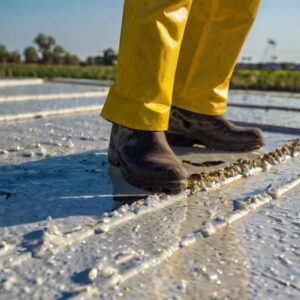Polyurea, an incredibly versatile material, has taken the protective coatings world by storm. Widely used in various industries, it boasts impressive features like rapid curing, high flexibility, and exceptional durability. One key aspect that affects polyurea’s performance is climate. Understanding how different weather conditions impact polyurea applications can be the difference between success and failure.
The Influence of Temperature
In regions where high temperatures are prevalent, the application and performance of polyurea coatings can be significantly impacted. One of the primary concerns in such environments is that polyurea can cure too quickly due to the excessive heat. This rapid curing process often results in insufficient time for the coating to properly bond with the substrate, potentially leading to adhesion failures. Additionally, prolonged exposure to high temperatures can cause the polyurea material to lose its inherent flexibility. Over time, this reduction in flexibility can contribute to cracking or other forms of degradation, particularly in applications where the coated surface is subject to movement or thermal expansion and contraction. Another issue that arises in high-temperature scenarios is related to surface preparation. Elevated temperatures can prompt substrates—especially porous ones like concrete—to release moisture trapped within. This moisture release can create a barrier that prevents the polyurea coating from adequately adhering to the substrate, thereby compromising the overall effectiveness of the protective layer.
To address these challenges, it is advisable to utilize specially formulated polyurea products designed for high-temperature applications. These formulations typically react more slowly, allowing for a more controlled curing process that ensures proper bonding and adhesion despite the heat. By selecting the appropriate polyurea formulation, it is possible to maintain the integrity and performance of the coating even in regions characterized by consistently high temperatures.
Low Temperature Scenarios

Low temperatures can dramatically alter the characteristics and performance of polyurea coatings, presenting a unique set of challenges. One of the most notable issues in cold environments is delayed curing. The lower temperatures slow down the chemical reaction necessary for the polyurea to harden, which can significantly extend the time required for the coating to fully cure. This delay can impede project timelines, especially in projects where timely completion is critical or where multiple layers of coating are required. As temperatures drop, the viscosity of polyurea increases. In layman’s terms, the material becomes much thicker, which complicates the application process. Thicker coatings are harder to spray or spread evenly, potentially resulting in an uneven surface that may not provide the desired level of protection or aesthetic finish.
Another drawback of applying polyurea in low-temperature conditions is the increased potential for cracking. As the material becomes more brittle in the cold, it is less capable of absorbing stress or maintaining its integrity under external forces. This brittleness can lead to cracks and fractures, especially in environments where the coated surface is subject to movement or thermal cycling, such as freeze-thaw conditions.
To mitigate these issues, it is essential to select polyurea formulations that are specifically designed for cold environments. These formulations often include adjusted catalysts that help maintain ideal curing times despite the lower temperatures. By choosing the right polyurea product and following best practices for cold-weather application, it is possible to achieve a durable and effective coating, even in challenging low-temperature scenarios. This approach helps ensure the long-term performance and reliability of polyurea coatings in a variety of climatic conditions.
High Humidity
In regions characterized by high humidity levels, the application and performance of polyurea coatings can be significantly compromised by a variety of issues. One of the primary concerns in such environments is foaming. During application, the excess moisture in the air can react with the polyurea, causing it to foam. This foaming affects the finish and appearance of the coating and weaken its structural integrity. Incomplete or improperly applied foam can create voids and weaknesses within the layer, undermining the coating’s protective qualities.
Another concern in high-humidity conditions is weak bonding. The presence of moisture can interfere with the polyurea’s ability to adhere effectively to substrates. This poor adhesion can result in delamination, where the coating peels away from the surface, exposing the underlying material to potential damage and reducing the overall efficacy of the protective layer. Weak bonding is particularly problematic in applications where strong adhesion is critical for the performance and longevity of the coating.
Blistering is a significant issue associated with high-humidity environments. After the polyurea has been applied, any residual moisture trapped beneath the coating can expand or contract with temperature changes, leading to the formation of blisters. These blisters mar the appearance of the coating and create entry points for environmental elements like water, chemicals, or UV light, which can further degrade the substrate.
To mitigate these potential issues, it is important to thoroughly prepare the surface before applying the polyurea coating. Ensuring that the substrate is completely dry and free of any moisture is an essential step. Using polyurea formulations that are specifically designed to tolerate moisture can help address the challenges posed by high humidity. These moisture-tolerant formulations are formulated to bond effectively even in the presence of some moisture, reducing the risk of foaming, weak bonding, and blistering. By taking these precautions, one can significantly enhance the performance and durability of polyurea coatings in humid environments, ensuring a long-lasting and effective protective layer.
Low Humidity
While low humidity might seem advantageous, it comes with its set of problems:
- Rapid Evaporation: solvents and other components may evaporate too quickly, affecting the consistency.
- Static Electricity: can attract dust and other contaminants, compromising the coating.
- Mixing Challenges: added difficulties in mixing components correctly.
Application Tip: adjust the spraying equipment settings to counter rapid evaporation and ensure thorough mixing for consistent application.
